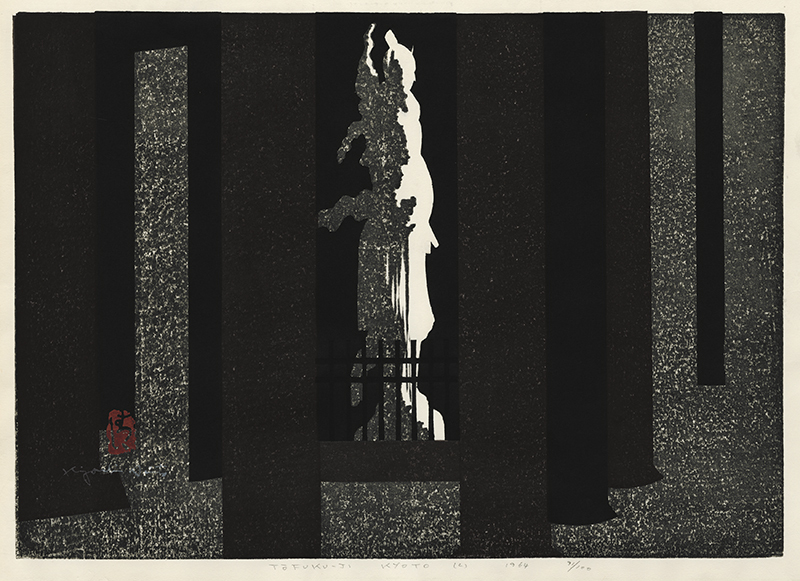
19th, 20th & 21st Century Fine Prints
707-546-7352 · fax 707-546-7924 · web: www.annexgalleries.com · email: artannex@aol.com
Tofuku-Ji, Kyoto (C) by Kiyoshi Saito

Tofuku-Ji, Kyoto (C)
Kiyoshi Saito
Tofuku-Ji, Kyoto (C)
Kiyoshi Saito
1907 - 1997 (biography)A scene of the courtyard of the Tofuku-ji Temple, the oldest standing Zen temple in Japan, dating to the 13th century. In the center of the image is one of the Four Heavenly Kings statues, as seen in strong chiaroscuro between the wooden pillars of the temple. The Four Heavenly Kings are the four gods of Buddhism that protect the four directions. The temple hosts the Jikokuten statue (Jikokuten-zo) of the east, the Zojoten statue (Zojoten-zo) of the south, the Komokuten (Komokuten-zo) statue of the west, and the Tamokuten statue (Tamonten-zo) of the North.
Kiyoshi Saito was born on April 27, 1907 in Aizubange, Fukushima, Japan on the main island of Honshu. When he was five years old, his father lost his business in Fukushima and the family moved further north to the island of Hokkaido, where his father worked in the coal mines in Otaru. When he was thirteen years old, his mother died and he was sent away to become the guardian of a buddhist temple. He tried to escape but failed. Nevertheless the priests allowed him to return home. Saito then went to Hokkaido, where he took on a sign painting apprenticeship. At that time he dreamed of becoming a painter and he began to sketch on gypsum casts at night.
He founded his first sign painting business before his twentieth birthday and ensured himself a living and modest financial success. He reluctantly abandoned it, however, to study art in Tokyo. For the time being he was content with studying illustrations in western newspapers. In 1932 Kiyoshi Saito moved to Tokyo. He first worked as a sign painter and then later from 1944 until 1954 as an employee of the Asahi Newspaper Company. The job however was a secondary matter. More importantly, Saito came into close contact with the printmaker Shiko Munakata. He continued to paint with oils and taught himself the technques of color woodblock printing. In 1937 he exhibited both oils and woodcuts for the first time in the famous Kokugakai Exhibition and was highly motivated when he met Ono Tadashige at the Ginza Exhibition in 1939.
His acquaintance with the artist Koshiro Onchi himself a mentor of the sosaku hanga movement soon opened doors to galleries, where most notably American purchasers took an interest in Saito's work. He became best known as a sosaku hanga printmaker in mid 20th century. Saito's early works depicted villages that were populated by local Japanese men and women with a great degree of realism and three-dimensionality. He became most famous for his "Winter in Aizu" series of woodcuts, and he was one of the first Japanese printmaking artists to have won a prize at the Sao Paulo Biennale in 1951, opening up new doors for sosaku hanga printmakers, who had been dismissed as too western in Japan. After the Biennale his career took off, both in Japan and internationally.
His later work merged modern elements of modernism, cubism, abstraction, and impressionism with Japanese tradition, after having been influenced by famous modern artists such as Piet Mondrian, Pablo Picasso, Henri Matisse, Wassily Kandinsky, Paul Gauguin, and Edvard Munch.
Kiyoshi Saito died in Japan on November 14, 1997.


